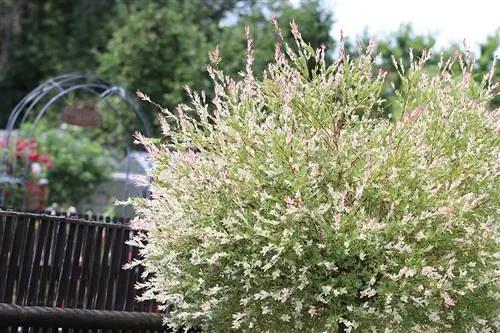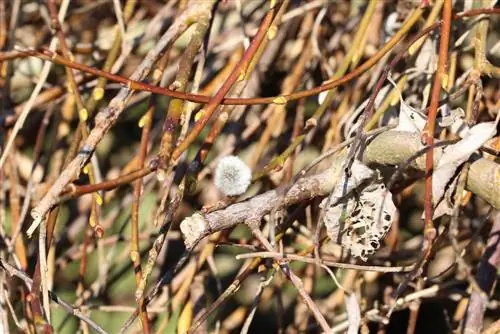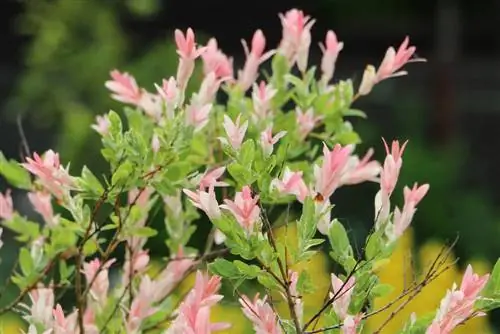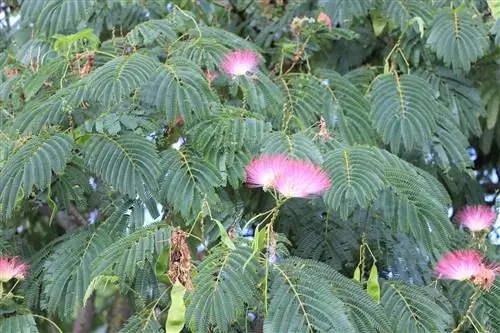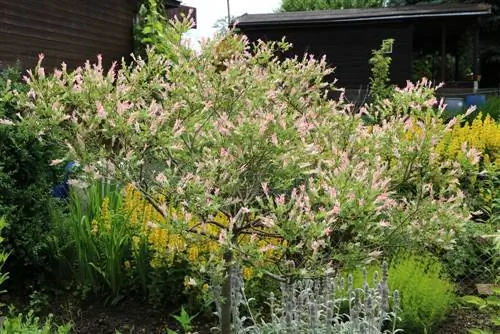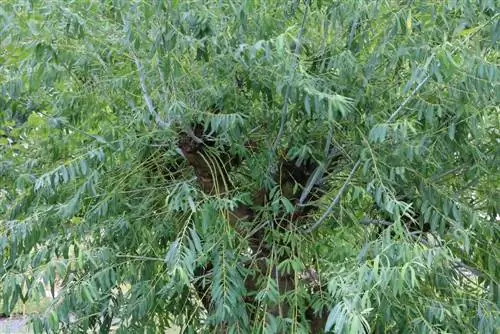- Author admin [email protected].
- Public 2023-12-17 03:39.
- Last modified 2025-01-24 12:45.
This ornamental willow is characterized by its spherical, broad and stocky growth as well as its strikingly variegated leaves. It doesn't get very big and is therefore an ornament even when there is little space.
Profile
- Plant family: Willow family (Salicaceae)
- Origin: Japan
- Growth: compact shrub or trunk, spherical crown
- Growth height: 150-300 cm
- Leaves: shoots pink, green-white variegated, tinged with pink
- Flowers: unfilled, inconspicuous yellow catkins
- Flowering time: March to April
- Fruit: brown, hairy capsule fruits
- Lime compatibility: lime tolerant
- Toxicity: non-toxic
Site conditions
The coloring of the leaves of the flamingo tree depends primarily on the light intensity. The more light, the more intense the color. She can best showcase her appearance in the sun. However, you should avoid a location in the blazing midday sun, otherwise the leaves could burn. In partial shade they lose some of their luminosity and remain brighter. The coloring is almost completely lost in the shade.
Soil texture
The soil should ideally be fresh to moist, loose and nutrient-rich and have good water storage capacity. You should make sure that the soil is moist enough, especially in sunny locations. Otherwise, the flamingo willow and normal garden soil is completely sufficient. If you enrich it with mulch or compost, you've done everything right.
Planting
The Harlequin willow can be planted in spring and autumn. Container plants all year round provided the soil is frost-free. Planting in spring has the advantage that the plant has enough time to take root before the first frost. You should avoid planting in summer.
- Dig a sufficiently large planting hole
- Insert the willow in the middle
- Fill with excavated earth
- Water the soil abundantly
- Planting distances between 80 and 150 cm
- Insert stake on trunk
- Best towards the weather side
- Stake should give the stem stability
- Attach to the trunk using coconut rope
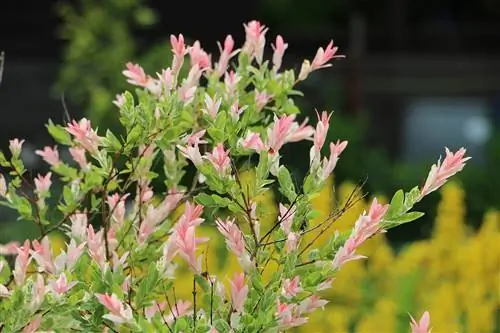
The stake is intended to prevent fine root tissue from being damaged by strong winds. Since the roots run relatively shallowly below the surface, it is important to ensure that the planters are sufficiently large, especially when planting in containers.
Tip:
The extraordinary foliage color is best displayed in a solitary planting. There are also numerous options for underplanting.
Care instructions
Pouring
Watering is particularly important in the first few weeks after planting. The soil should be kept as moist as possible and not allowed to dry out. This means the flamingo tree can quickly gain a foothold. Of course, waterlogging should be avoided. Water later as soon as the top layer of soil has dried. Mature harlequin willows also tolerate longer dry periods. Nevertheless, in particularly hot and dry weather, watering should be carried out occasionally, at the latest when the leaves begin to curl. It is best to water exclusively with rainwater. Specimens in pots need to be watered more frequently due to their smaller volume.
Fertilize
Basically, the flamingo tree has no special demands on the soil. If you add some compost when planting or mulch the tree disc so that the leaves emerge in spring, you can usually do without additional fertilizer. At the same time, mulch ensures that the soil does not dry out so quickly. When kept in a container, a complete fertilizer is administered annually when the leaves emerge. From August onwards there will be no more fertilization.
Cutting
Pruning measures are the be-all and end-all for the flamingo willow. They prevent overgrowth, prevent the branches from becoming woody, ensure that the plant retains its shape and the crown grows denser and bushier. It is best to choose an overcast, frost-free day for cutting. Exclusion criteria are full sun and dryness as well as the closed periods during the breeding seasons of numerous bird species.
High Stems
Topiary
High-stem flamingo willows are grafted onto osier, which is known for strong branch growth. Without cutting, over the years it would lose its spherical shape, which ensures unhindered light penetration. As a result, appropriate topiary pruning is recommended in late winter. Smaller topiary cuts can also be carried out in the following months if necessary.
- Cut back the crown and remove dead wood
- Cut off old and weak branches at the base
- Short all remaining branches to a third
- Short it down a little more
- This results in stronger budding
- Never deeper than three eyes
- Do not cut into the grafted trunk
- Last topiary in late summer
Tip:
So-called bypass scissors are recommended for cutting. It enables precise cutting and avoids bruising.
care cut
The maintenance cut serves to create a more compact crown shape and to maintain the variegated leaves. The topiary results in vigorous growth, which requires further care pruning in the summer.
- Best time around St. John's Day at the end of June
- Plants are now entering a growth phase
- This is followed by a second but weaker shoot
- Crown cut back by a third
- Half that is no problem either
- Or just shorten branches that protrude from the crown
- Remove shoots that emerge from the trunk or root disc

More radical cut
A more radical pruning is recommended if the harlequin willow has not been pruned for a long time. Thanks to the high cutting tolerance, this is possible without any problems.
- Best time is in spring
- Short shoots to up to ten centimeters
- Leave at least four eyes per shoot
- Cut out diseased and dead shoots
- Remove cross-growing crown shoots
- Don't leave stubs on the plant
Tip:
Severe pruning should not be done in autumn. The interfaces would heal more poorly and the plants would be more susceptible to frost damage.
Pruning bushes
Plant cutting
- The goal is a dense branching at the base
- Best time right after planting
- Cut back bare-rooted young bushes by half
- Short container plants by a third
- Pruning causes stagnation of sap on the lower buds
- This results in increased shoots at the base of the bush
- More lush branching on the harlequin bush
Conservation cut
After the planting has been cut, the harlequin willow can be left alone for the next two to three years. From the third year onwards it is time for the first maintenance cut.
- Ideally between January and the beginning of March
- Be sure to choose a frost-free day
- The goal is a spherical, compact shrub shape
- Thin out dead wood at the base
- As well as inwardly growing or crossing shoots
Shape and care cut
A topiary pruning is also recommended for the shrub shape, which follows the maintenance pruning. Not all, but only the outer branches should be cut back. This creates a beautiful hemispherical shape. You shorten it by at least a third so that the sprouting of this year's young shoots is encouraged.
For opaque growth and a beautiful appearance, the first pruning of the shrub follows in the summer of the third year. The shoots in the outer area are shortened more than those in the center.
Rejuvenate / Put on the stick
To revitalize an aging flamingo tree, you can put it on the stick. With this cut, the shrub is cut back to a few centimeters above the ground. This means that sleeping buds are activated, which in turn causes new growth. There is no need to cut out individual bare branches and growth is promoted.
Tip:
If the harlequin willow is used as a hedge plant, it is sufficient to shorten it by two thirds every two years.
Wintering
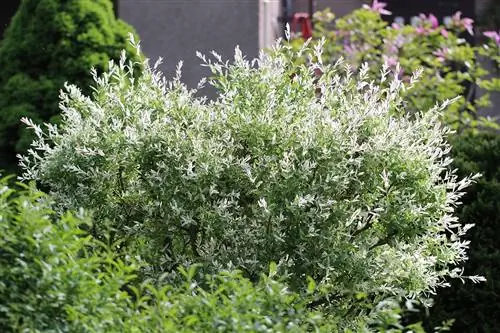
A flamingo willow planted in a bed needs no winter protection. It's different in the pot, here the roots have to be protected. To do this, cover the root area with mulch and wrap the bucket with jute, bubble wrap or similar insulating materials. It is best to place it in a protected place near the house. It is not advisable to overwinter indoors. In the case of tall stems, the crown is also wrapped with fleece to protect it from the intense winter sun.
Propagate Harlequin Willow
- Propagation occurs via cuttings
- Cut cuttings about 15 cm long
- Let it root in a glass of water
- Then place in small pots with a soil-sand mixture
- Keep substrate evenly moist
- Plant in place in spring
- Water regularly until established
Diseases & Pests
Fungal infestation
The flamingo willow is susceptible to fungal diseases such as rust, willow scab and willow anthracnose. An infestation occurs in wet weather in May or June. It is shown by brown or black, scabby leaves, wilted shoot tips and leaf drop. Affected plants should be cut back severely, if necessary to a few centimeters above the ground. The resulting clippings are disposed of in household waste and not in compost.
Willow Borer
The willow borer caterpillars leave feeding passages up to two centimeters thick. Drill holes can be seen in the bark, drill dust and fecal crumbs at the base of the trunk. The intense smell of vinegar is also noticeable. Infected plants should be cut back to he althy wood.
Willow Leaf Beetle
The willow leaf beetle also draws attention to itself through feeding marks and wilted, brown or black leaves. This can result in complete baldness. In addition to the feeding marks, you can see orange egg deposits on the leaves. The affected plant parts should be removed and discarded. In addition, treatment with a suitable fungicide is recommended.

